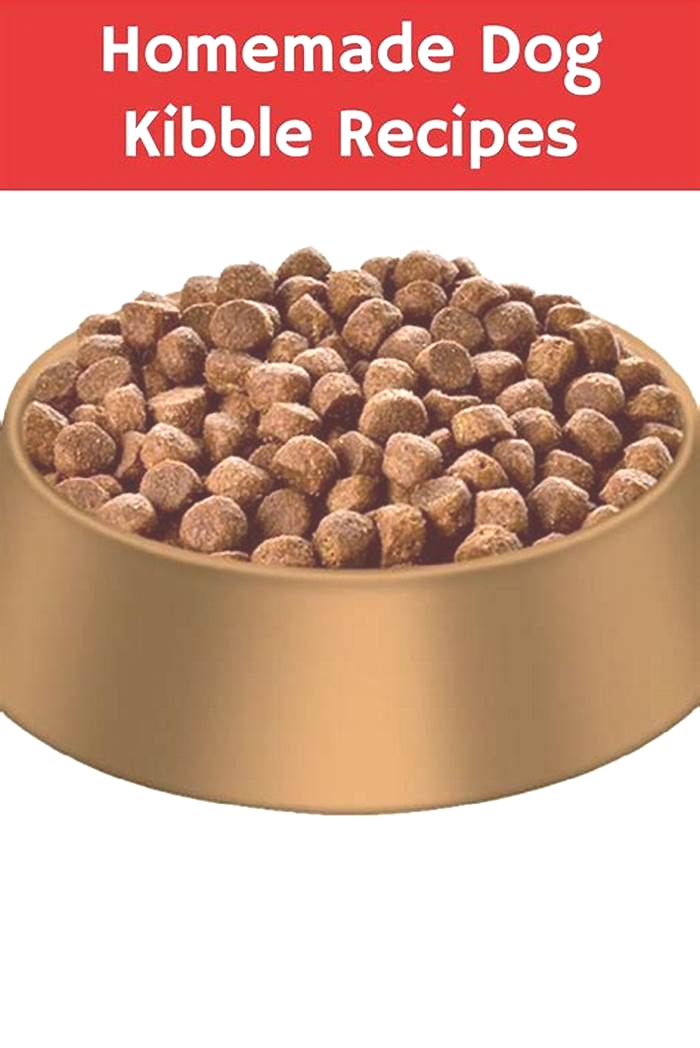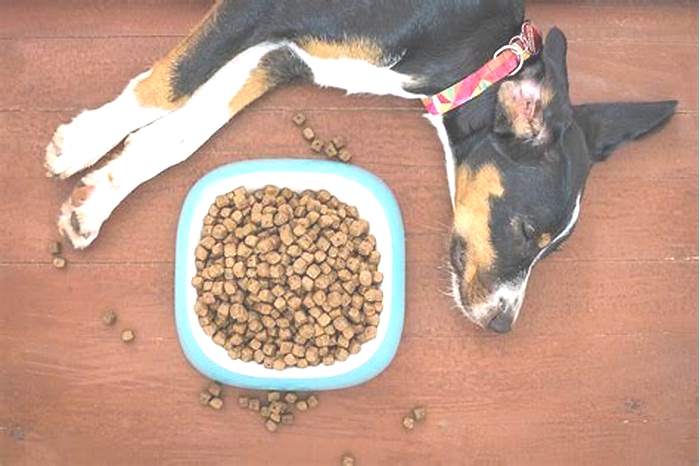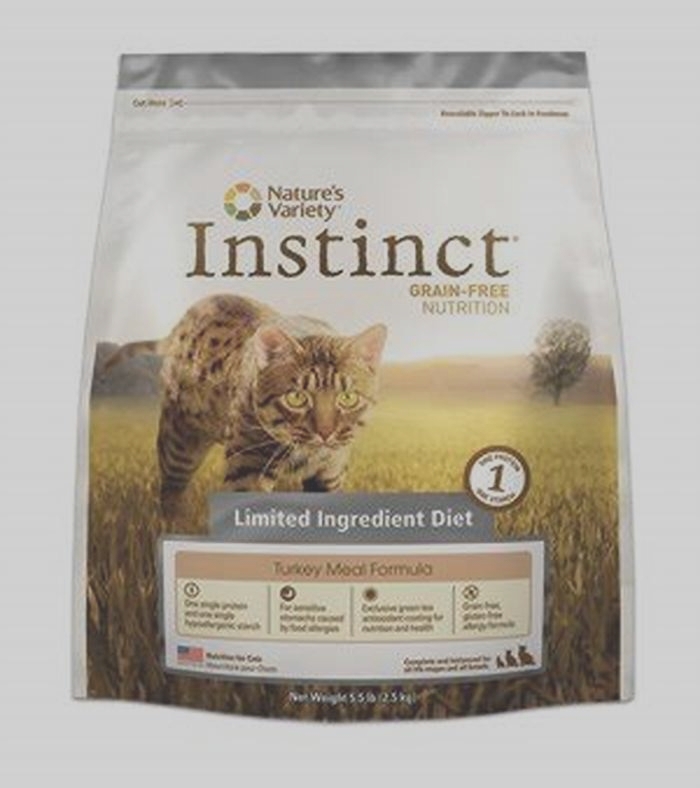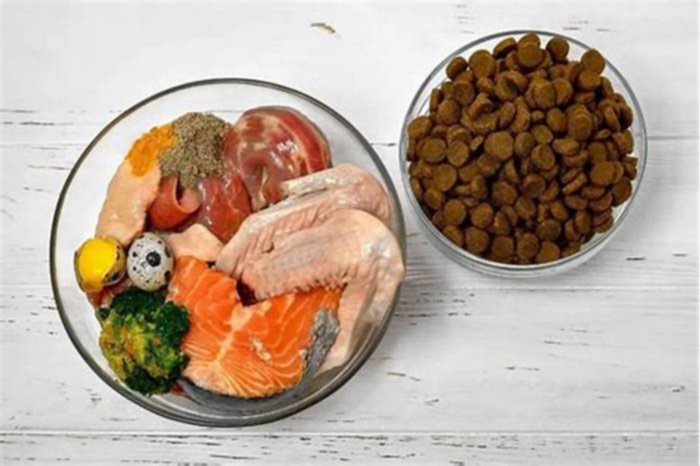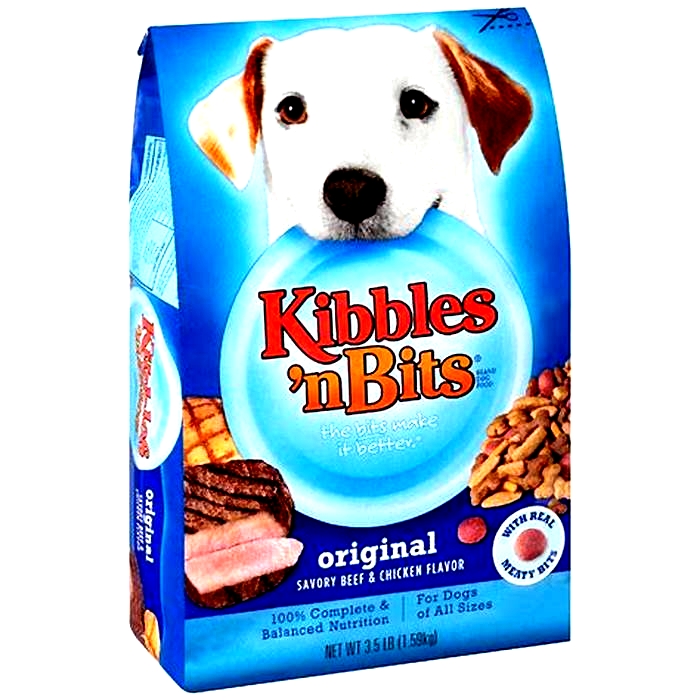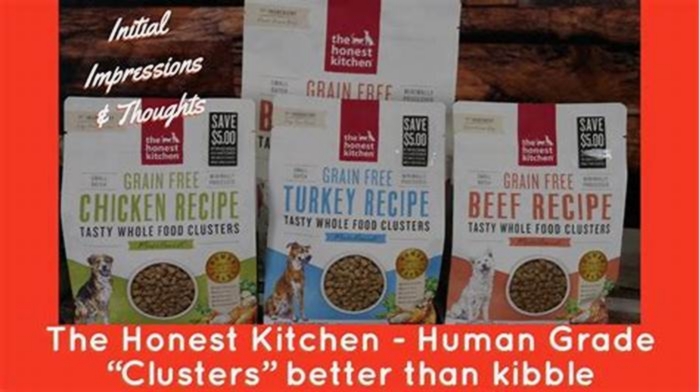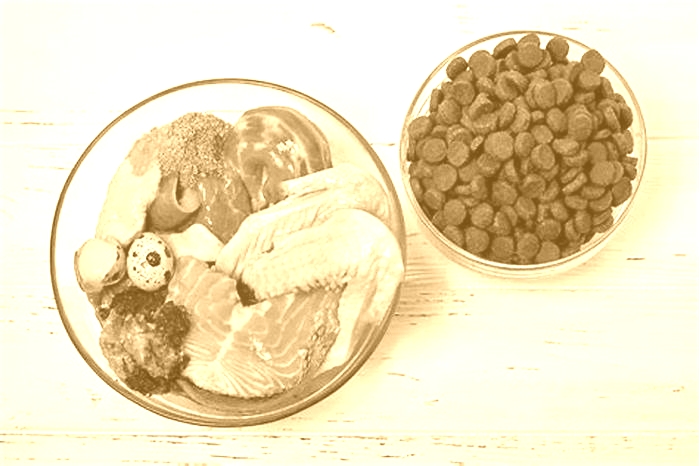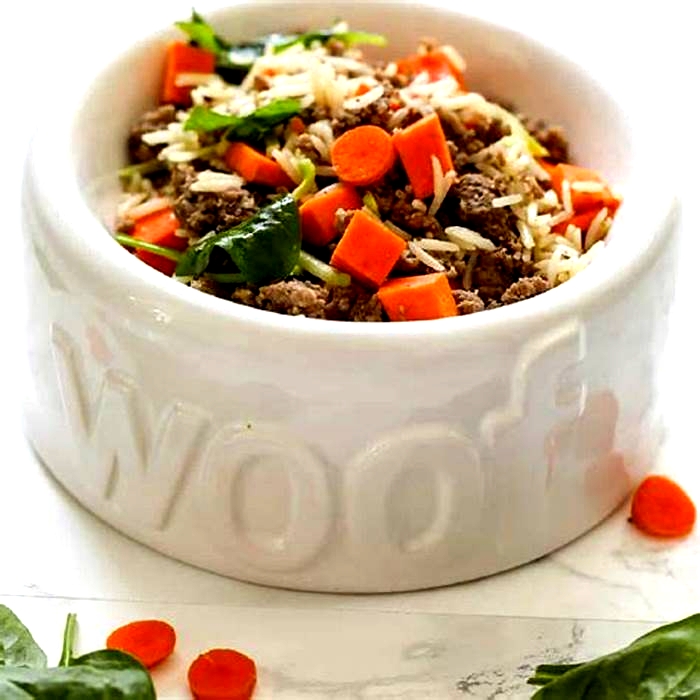homemade dog food to add to kibble
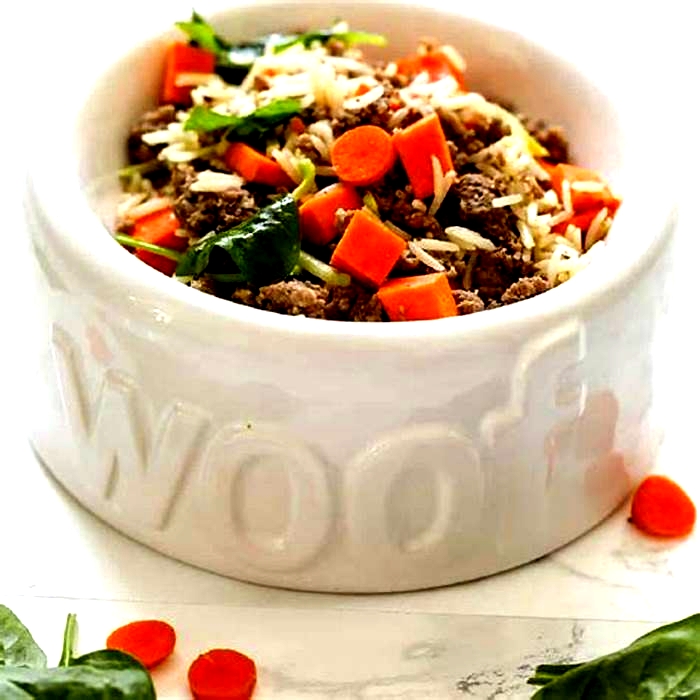
Adding Fresh Food to Kibble (50+ Healthy Options!)
One of the most common questions I get from people we are currently feeding kibble, but are interested in adding fresh food to kibble is How do I do add fresh food to kibble? What do I add to the bowl? And How often do I add these fresh foods to kibble for my dog?
These are great questions! And this post is going to outline exactly which foods are amazing additions to your dogs food, and which ones you might want to reconsider.
A little Fresh Food Added to Kibble
You dont have to transition fully onto a fresh food diet in order to get some of the benefits of fresh food. A research study published by Perdue in 2005 found that Scottish Terriers who were fed fresh vegetables just three times per week had a significantly lower cancer rate in comparison to those who just ate a kibbled diet.
And though I cannot promise some of the other benefits of fresh food like increased digestibility by adding in a bit of fresh vegetables to your dogs diet. This research suggests those antioxidants and phytonutrients may be very helpful to your pup.
How Much Fresh Food is Too Much?
When you are considering adding healthy fresh food to kibble its important to know that board certified veterinary nutritionists recommend keeping all treats and additions under 10% of your dogs overall diet. The main reason for this recommendation is so we dont accidently unbalance our dogs diet by adding fresh food.
There is such a thing as too much of a good thing.
- Too much broccoli may give your dog diarrhea because of the high amount of insoluble fiber.
- Excessive beef liver may cause copper or vitamin A toxicity because the body cannot excrete/store excess effectively.
- Large amounts of fish could cause vitamin D toxicity.
Much of nutrition isnt just about one nutrient but about the balance and interactions of different nutrients within a diet as a whole. Our goal with these additions is to provide benefits and avoid risks.
How much fresh food is 10%?
Many people get confused as to what goes in this 10% category and how much 10% really is. When we talk about 10% we are speaking about 10% of your dogs daily caloric intake. So in other words 90% of those calories should come from a complete and balanced diet, and 10% of those calories can come from treats, chews, supplements and additions.
Let me give you an exampleA ten-pound chihuahua needs about 250 calories per day. This means that 25 calories (10%) can come from treats, chews, supplements and additions, and 225 calories (90%) should come from the complete and balanced diet.
Depending on the size of your dog, and their activity level the amount of calories they will eat per day will vary (similar to people!). If you need help estimating your dogs caloric needs make sure to check out my blog post.
Healthy Kibble Add-Ins
When we consider adding something to an already complete and balanced diet like a kibble what we are looking to do is enhance it not take away from it. And though you can add in items just because your dog enjoys them, I would advise using these for other purposes like training rather than as just a kibble topper.
The real exception to this is if you have a picky dog. If your dog is picky Id advise speaking to your vet prior to topping their food with tasty treats. The main reason for this is because pickiness can be due to underlying medical conditions. And just making the kibble more appealing might not actually be in your dogs best interest.
Ive also personally found that truly picky dogs will often eat around foods they dont like. Which means if you give your picky dog tasty fresh food additions on their kibble they will just eat those and leave the kibble. In these cases it is probably because to switch over to a complete and balanced fresh food.
I also want to caution that depending on your dog and their particular medical condition certain foods, however healthy, may not be advised. Always speak to your vet if your dog has a medical condition prior to adding fresh food to kibble, especially if on a prescription diet.
Adding Foods High in Antioxidants to Kibble
Probably my favorite food to add into a dogs bowl are those high in antioxidants. Antioxidants are almost magical in how they work. Basically what they do is scavenge free radicals in the body, lowering oxidative stress. Oxidative stress is actually one of the causes of inflammation within the body and can cause premature aging.
Every type of antioxidant works in a bit of a different way, and has their own benefits. So feeding a variety of foods high in antioxidants like fruits and vegetables can be very helpful. This is where statements like feed the rainbow become important. Most antioxidants are associated with a certain food color. So if you look to add a variety of colors and textures to their kibble they will get a variety of antioxidants.
The list below is by no means all-inclusive to which fruits and vegetables may be beneficial for adding to your dog food. But hopefully it can provide you with some inspiration going forward. Bonus that almost all of these foods are great low calorie options for treats too!
Adding Fresh Food to Kibble: Dog-Safe Fruits & Vegetables
Quercetin:
Quercetin has been shown to improve skin health and reduce inflammation for dogs with allergies. It works similar an antihistamine by inhibiting inflammatory mediators from mast cells. Though exact dosing isnt completely known, adding fresh foods to kibble with these antioxidants may be beneficial long-term. Fresh foods that are rich in quercetin that you can add to your dogs kibble are:
- Tomatoes
- Cherries
- Blueberries
- Raspberries
- Blackberries
- Brussel Sprouts
- Broccoli
- Red or Orange Bell Pepper
Catechins:
Research suggests catechins can help with oxidative stress, and help to scavenge free radicals. This is helpful to our dogs because oxidative stress can lead to cell and tissue damage. These damaged cells can cause or lead to disease such as allergies, and even certain types of cancer. Thus adding in some fresh foods high in these antioxidants may be beneficial. Fresh Foods you can add to your dogs food to reduce oxidative stress are:
- Blueberries
- Raspberries
- Apples
- Cherries
- Decaffeinated Green Tea
Anthocyanins are an antioxidant that give the red-purple color to foods. Limited research suggests that they may have potential benefits with certain types of cancer, heart conditions, and can help restore good cell metabolism. Fresh Foods you can add to your dogs food to restore good cel metabolism are:
- Blackberries
- Cranberries
- Cherries
- Red Cabbage
- Red radish
- Pomegranates
Lycopene:
Limited research on cancer cells suggests lycopene may be helpful as an adjunctive therapy for dogs with bone cancer. Further research is still being done, however adding on food rich in these antioxidants (and others) may have some benefits. Fresh Foods you can add to your dogs food that contain lycopene are:
- Guava
- Tomato
- Watermelon
- Grapefruit
- Papaya
- Red Bell Pepper
- Persimmon
- Asparagus
- Red Cabbage
- Mango
Sulforaphane:
The powder of cuciferous vegetables and cancer was first investigated in 2005, and since then several further research studies have been done to further evaluate exactly how these foods inhibit cancer formulation. Current research suggests that an antioxidant called sulforaphane found in these vegetables may be the reason. Sulforaphane has been shown to decrease cancer cell proliferation by inhibiting histone deacetylase (HDAC). Further study looking at supplementation of Broccoli Sprouts in dogs has found that supplementation can decrease HDAC activity by up to 25%. Fresh Foods you can add to your dogs food that contain sulforaphane are:
- Broccoli Sprouts
- Broccoli
- Cauliflower
- Kale
- Brussel Sprouts
- Cabbage
- Bok choy
- Watercress
Kaempferol:
Kaempferol is an antioxidant that works to scavenge free radicals and reduce oxidative stress. Current research suggests it is most beneficial for cognitive health and to reduce cancer incidence. However the true mechanism of action still remains unknown. Fresh Foods you can add to your dogs food that contain kaepferol are:
- Spinach
- Kale
- Dill
- Tarragon
- Watercress
- Mustard Greens
- Arugula
- Turnup Greens
- Swiss Chard
- Collard Greens
- Celery
Flavonoids:
There are many different types of other flavonoids out there that have been shown through research to help with inflammation, and oxidative stress. In general feeding a variety of different fruits and vegetables will lead to getting a variety of these compounds within a diet. Other fresh foods high in flavonoids that you can add to your dogs food are:
- Parsley
- Bell Peppers
- Celery
- Apples
- Cantalope
- Cucumber
- Carrots
- Pineapple
- Cauliflower
Beta-Glucans (Polysaccharide K):
Did you know that dogs can in-fact eat mushrooms? Yep . Generally speaking, if the mushroom is poisonous to you, its poisonous to your dog. But most mushrooms we can purchase to eat in our local grocery stores are actually completely safe for our dogs to eat. Mushrooms can also be beneficial to dogs because they contain beta-glycans.
Beta-glycans are within the mushroom cell wall and directly influence your dogs immune system. Limited research in dogs has also suggested that purified PSP (a component of beta-glycans) have an anti-tumor effect in dogs. This research found that dogs with hemangiosarcoma given high doses of PSP it delayed cancer progression and increased survival time.
Some foods high in beta-glucans that can be added to kibble are:
- Shiitake Mushroom
- Maitake Mushroom
- Lions Main Mushroom
- Turkey Tail Mushroom
- Chaga Mushroom
- Reishi Mushroom
Other Healthy Fresh Food Add-Ins for Kibble
When you think of adding in fresh food to kibble I want you to focus on fresh fruits and vegetables. These have all those wonderful antioxidants and polyphenols that help with oxidative stress, cancer, and inflammation. Though the other options we will be talking about below are wonderful they can be calorically dense. And as we know that keeping your dog as a healthy weight can increase their lifespan by 1-3 years.
But many of these may make excellent high value treats for training purposes. Or they may be a great way to flavor fruits and veggies to make your pup more excited to eat them. Just remember we want all treats, additions and chews to make up 10% of the overall diet! If you would like to add more fresh food to your dogs diet would highly suggest considering a complete and balanced fresh food diet.
The Best Organs to Add to Kibble
Probably the most popular treat that most people use for training purposes are organ meats. This is because they are smelly- and most dogs enjoy them. They are also nutritional powerhouses, and are very nutritionally dense. This can be a good thing, however it can also be dangerous as too much of certain vitamins or minerals can cause health problems.
This is part of the reason why making sure you dont give more than 10% of the diet as any of these foods is so important.
- Beef Heart: 32 calories per ounce. A rich source of folate, iron, zinc and selenium
- Chicken Heart: 52 calories per ounce. A great source of vitamin B12, zinc, and iron.
- Pork Heart: 33 calories per ounce. A good source of iron, zinc, thiamine, vitamin B2, niacin, vitamin B6 and vitamin B12.
- Chicken Gizzard: 29 calories per ounce. An excellent source of vitamin B12, niacin, magnesium, copper, and manganese.
- Beef Tripe: 28 calories per ounce. A rich source of vitamin B12, selenium, and zinc.
- Lamb Lung: 27 calories per ounce. A high quality source of vitamin B12, iron, and niacin.
- Beef Kidney: 29 calories per ounce. Contains a significant amount of vitamin B12, and riboflavin.
CAUTION WITH BEEF LIVER:Something I often see people over-use as a treat or a supplement is Beef Liver. Did you know that you can fill all you dog's vitamin A needs for a 50 lb dog with less than 1 ounce of beef liver? According to AAFCO per every 1000 calories a dog eats they should have a minimum of 1250 IU vitamin A. ONE, just ONE ounce of beef liver has over 5000 IU of Vitamin A.Though it would take over 12 ounces of beef liver within a total diet to get to toxic range (60,000 IU). If your dog's food is already on the upper-end of the allowable range you can see where problems may arise.Clinical Signs of an Over supplementation of Vitamin A are: lethargy, weakness, dry and flaky skin, bone spurs, joint abnormalities and painful movements.Copper Toxicity can also be a concern with high uses of Beef Liver as a treat or addition for dogs. AAFCO adjusted their requirements for copper in 2007 to remove the copper upper limit, prior to that period they did not allow over 71mg copper per 1000 calories. This adjustment has recently come under scrutiny because of an increase in liver disease associated with dietary copper.In just one ounce of beef liver you give almost 10mg of copper. With dog foods having no current upper limit - some are testing well-above previous maximums. Making it entirely possible to cause copper toxicity with the addition of beef liver as a treat.Clinical signs of an Over Supplementation of Copper: vomiting, diarrhea, excessive thirst,, depression, anorexia, weight loss and liver failure.

The Best Fish to Add to Kibble
Fish can be a great way to add omega 3 fatty acids to your dog food. The omega 3 fatty acids in particular EPA and DHA have been shown through multiple research studies over the years to be beneficial for numerous different disease and conditions.
Including: cognitive health, skin disease/allergies, joint health, heart disease and more. Its important to note that these conditions require mega-doses of EPA+DHA to be added to the diet. This would be more than what we might add as a treat or addition. Thus if you are dealing with these issues you may want to consider overall diet change rather than just these additions.
But generally healthy pets can benefit from the addition of oily fish to their diet as well, as it has been shown to help with inflammation and even oxidative stress.
- Sardines: 62 calories per ounce, 660 mg omega 3s
- Salmon: 59 calories per ounce, 650mg omega 3s
- Smelt: 72 calories per ounce, 430mg omega 3s
- Mackerel: 87 calories per ounce, 400mg omega 3s
- Herring: 45 calories per ounce, 500mg omega 3s
- Trout: 40 calories per ounce, 570mg omega 3s
- Cod: 49 calories per ounce, 197mg omega 3s
CAUTION ON OILY FISHJust like how beef liver is high in vitamin A and copper, our oily fish are particularly high in cautionary vitamin as well - VITAMIN D. According to AAFCO per every 1000 calories your dog should get no more than 750 IU of vitamin D.Salmon 149 IU vitamin D per ounceSardines 60 IU Vitamin D per ounceCod 10 IU Vitamin D per ounceDepending on the amount of vitamin D within your dog's regular diet, regular consumption of oily fish may or may not be an issue. But in order to be safe - I usually do not recommend adding on high vitamin D fish as a treat if your dog is already on a fish-based diet.Clinical signs of an Over Supplementation of Vitamin D are: vomiting, increased thirst and urination, excessive drooling, nausea, weight loss and loss of appetite. Ultimately this can lead to kidney failure.
Simple Bone Broth Recipe to Add to Kibble
If you have a picky eater or you want to add in some wonderful fresh fruits and vegetables but your dog just isnt a fan using a bone broth may be a great way to flavor your dogs meals. And though yes bone broth does contain minerals such as calcium, selenium, and magnesium they are not typically in high enough quantities to cause issues, especially if you are keeping this addition within 10% of your dogs caloric needs.
Adding fresh foods to kibble such as bone broth can provide additional hydration for dogs who struggle to drink enough water. And for dogs who need their kibble soaked to aide in digestion bone broth may be a great alternative to plain water.
Simple Bone Broth For Dogs:
- 4 large beef marrow bones, or left-over chicken carcus
- 12 cups water
- 2 tbsp apple cider vinegar (optional)
Cook on low for 12-24 hours in a crock pot or large pot on the stove.
Makes about 12 cups of bone broth. This will save in the fridge for 5 days, or in your freezer for up to a month. I highly suggest packaging the bone broth in servings sizes to make it easier to thaw/store.
Each cup is about 30 calories.
Adding Milk or Yogurt to Kibble
When considering adding in any type of dairy product into your dogs diet there are several factors to consider. First it is important to understand that not all dogs tolerate milk products. Many dogs are actually lactose intolerant, which means they will be unable to digest diary products, leading to loose stools. Also most milk products such as goats milk are very high in fat, and calorically dense. Making it very easy to over-supplement above that 10% of recommended calories coming from treats/additions, and causing loose stools due to the higher fat content.
However for picky dogs using goats milk or kefir it may be beneficial to keep them eating consistently. You can also use these milks to hide vegetables or other beneficial treats. Kefir also offer additional benefits as it does contain probiotic bacteria, however its important to note that not all the bacteria in kefir are ideal for dogs.
In fact only the Lactobacillus acidophilus strain found in kefir is beneficial. The rest of the strains (Bifidobacterium bifidum, Streptococcus thermophilus, Lactobacillus delbrueckii subsp.bulgaricus, Lactobacillus helveticus, Lactobacillus kefiranofaciens, Lactococcus lactis, and Leuconostoc species) are not species appropriate strains for dogs. This is one of the main reasons why probiotic supplements may be a better choice for dogs with gastrointestinal upset than kefir.
- Goat Milk: 168 calories per cup, 21 calories per ounce. 300-400 mg calcium per cup, or about 40 mg per ounce
- Kefir: 161 calories per cup, 17 calories per ounce. 300-400 mg calcium per cup, or about 40 mg per ounce
- Non-Fat Greek Yogurt (plain, unsweetened): 80 calories per cup, 270 mg calcium per cup
CAUTION CONCERNING CALCIUMFor most dogs keeping milk products within the 10% of calories per day will prevent issues with excess calcium. However for growing puppies which need a controlled level of calcium, and specific ratio of calcium to phosphorus it may be best to limit the amount of milk products added to the diet. This will avoid a potential of unbalancing these very specific ratios and allow for optimal growth and bone formation.
Going Beyond Additions
Are you finding yourself loving adding foods to your pups bowl so much that you are struggling to keep them within the 10% of your dogs caloric needs? Then consider adding on a fresh food complete and balanced diet! You can do this by either cooking a complete and balanced meal, or by purchase a premade fresh food for dogs. This can allow you to feed 25% or even 50% fresh food without worrying about nutritional imbalances.

About the Author: Nikki is a Registered Veterinary Technician (Veterinary Nurse) and Dog Mom with over a decade of experience with dogs and cats. Since graduation from college (BS Biology, Dip. Animal Nutrition, AS Animal Science) she has adopted two mixed breed dogs Ranger and Ash, and has focused her time learning about pet food and nutrition.
Nikki shares information on a range of pet nutrition topics: from how to create a homemade complete and balanced dog and cat food recipes, to how to choose a pet food. Nikki strives to give dog and cat parents the information they need in order to make the best nutrition decisions for their pet!
You should receive your Free Dog Food Recipe Ebook within 24 hours of subscribing! Make sure to check your spam folder. The recipe ebook is over 90 pages long so make sure you have a good internet connection when you go to download it. Afterwards you will receive weekly Canine Nutrition Updates every Tuesday on different topics related to canine nutrition & homemade dog food!
CONTACT ME:


Homemade Turkey and Quinoa dog food recipe which is perfect for dogs who are highly active, picky dogs, or those that have chicken allergies!

The age-old question of how much dog food should I feed my dog is actually both rather simple and complicated. What you need to understand to start out is that just like each person has a different metabolism and activity level dogs are similar. With the added complexity that dogs also come in a

A beginners guide to home-cooked dog food: where to find complete and balanced dog food recipes, how to use a base mix to cook for your dog, and where to find a board-certified veterinary nutritionist to work with!

